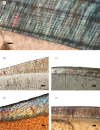Enamel formation and growth in non-mammalian cynodonts
- PMID: 29892415
- PMCID: PMC5990740
- DOI: 10.1098/rsos.172293
Enamel formation and growth in non-mammalian cynodonts
Abstract
The early evolution of mammals is associated with the linked evolutionary origin of diphyodont tooth replacement, rapid juvenile growth and determinate adult growth. However, specific relationships among these characters during non-mammalian cynodont evolution require further exploration. Here, polarized light microscopy revealed incremental lines, resembling daily laminations of extant mammals, in histological sections of enamel in eight non-mammalian cynodont species. In the more basal non-probainognathian group, enamel extends extremely rapidly from cusp to cervix. By contrast, the enamel of mammaliamorphs is gradually accreted, with slow rates of crown extension, more typical of the majority of non-hypsodont crown mammals. These results are consistent with the reduction in dental replacement rate across the non-mammalian cynodont lineage, with greater rates of crown extension required in most non-probainognathians, and slower crown extension rates permitted in mammaliamorphs, which have reduced patterns of dental replacement in comparison with many non-probainognathians. The evolution of mammal-like growth patterns, with faster juvenile growth and more abruptly terminating adult growth, is linked with this reduction in dental replacement rates and may provide an additional explanation for the observed pattern in enamel growth rates. It is possible that the reduction in enamel extension rates in mammaliamorphs reflects an underlying reduction in skeletal growth rates at the time of postcanine formation, due to a more abruptly terminating pattern of adult growth in these more mammal-like, crownward species.
Keywords: cynodont; dental histology; enamel development; enamel increment; mammaliaform; mammaliamorph.
Conflict of interest statement
The authors declare no competing interests.
Figures







References
-
- Dean MC. 1987. Growth layers and incremental markings in hard tissues: a review of the literature and some preliminary observations about enamel structure in Paranthropus boisei. J. Hum. Evol. 16, 157–172. (doi:10.1016/0047-2484(87)90074-1) - DOI
-
- Dean MC. 1995. The nature and periodicity of incremental lines in primate dentine and their relationship to periradicular bands in OH 16 (Homo habilis). In Aspects of dental biology: paleontology, anthropology and evolution (ed. Moggi-Cecchi J.), pp. 239–265. Florence, Italy: International Institute for the Study of Man.
-
- Smith TM. 2006. Experimental determination of the periodicity of incremental features in enamel. J. Anat. 208, 99–113. (doi:10.1111/j.1469-7580.2006.00499.x) - DOI - PMC - PubMed
-
- Smith TM. 2008. Incremental dental development: methods and applications in hominoid evolutionary studies. J. Hum. Evol. 54, 205–224. (doi:10.1016/j.jhevol.2007.09.020) - DOI - PubMed
-
- Shellis RP. 1998. Utilization of periodic markings in enamel to obtain information on tooth growth. J. Hum. Evol. 35, 387–400. (doi:10.1006/jhev.1998.0260) - DOI - PubMed
Associated data
LinkOut - more resources
Full Text Sources
Other Literature Sources
